|
 Hypholoma acutum Hypholoma acutum
SynonymsAgaricus acutus
Naucoria acuta
Hypholoma fasciculare
Agaricus fascicularis
Naematoloma acutum
BiostatusPresent in region - Indigenous. Endemic
Images (click to enlarge) | 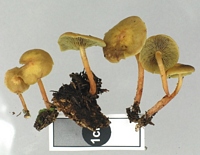
Owner: J.A. Cooper | 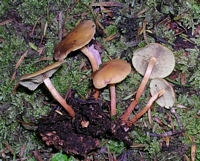
Owner: J.A. Cooper | 
Caption: 2-Hypholoma acutum: a. spores; b. chrysocystidia. | 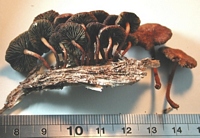
Caption: fruitbody
Owner: J.A. Cooper | 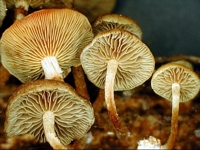
Owner: J.A. Cooper | 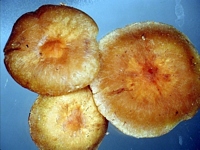
Owner: J.A. Cooper | 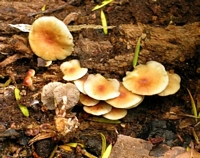
Caption: Picture Helen Greenep
Owner: J.A. Cooper | 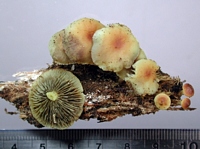
Owner: J.A. Cooper | 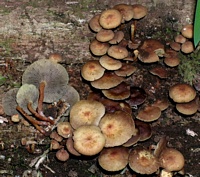
Owner: J.A. Cooper | 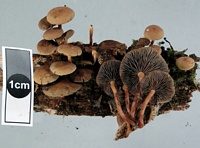
Owner: J.A. Cooper | 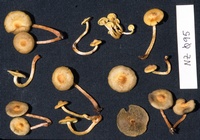
Caption: ZT9361, NZ-95
Owner: E. Horak: © Creative Commons Attribution-Noncommercial 3.0 New Zealand | 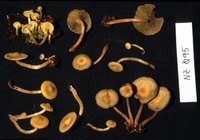
Caption: ZT9361, NZ-95
Owner: E. Horak: © Creative Commons Attribution-Noncommercial 3.0 New Zealand | 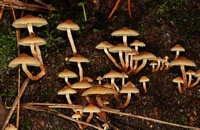
Owner: J.A. Cooper | 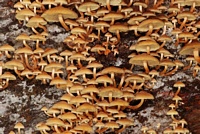
Owner: J.A. Cooper | 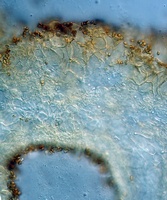
Caption: section through cap showing subepidermal spherical cells characteristic of Hypholoma
Owner: J.A. Cooper | 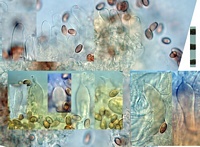
Caption: upper: cheilocystidia (Melzers). Lower left: pleurocystidia; right: caulocystidia (KOH)
Owner: J.A. Cooper | 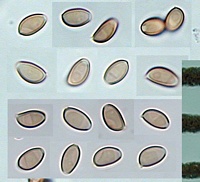
Owner: J.A. Cooper | 
Owner: B.P. Segedin | 
Caption: 104-Hypholoma acutum [(COLENSO b 408)]: a. spores; b. chrysocystidia. | |
Article: Horak, E. (1971). A contribution towards the revision of the Agaricales (Fungi) from New Zealand. New Zealand Journal of Botany 9(3): 403-462 (http://www.rsnz.org/publish/abstracts.php).
Description: Examination of the well preserved type collection (COLENSO b 48) shows that this distinct
species belongs to Hypholoma (Fr.) Kummer and accordingly the combination Hypholoma
acutum (Cooke) comb. nov. is proposed.
(Basionym: Agaricus (Naucoria) acutus Cooke, Grevillea 14: 129, 1886)
Article: Cooke, M.C. (1886). Some exotic fungi. Grevillea 14(72): 129–130.
Notes: Allied to Agaricus camerinus and Ag. triscopus.
Article: Massee, G.E. (1899) [1898]. The fungus flora of New Zealand. Transactions and Proceedings of the New Zealand Institute 31: 282–349 Wellington:.
Description: Pileus fleshy, conico-campanulate, acutely umbonate, glabrous; even, opaque, ochraceous, 3-5 mm. broad ; gills adnate,
somewhat crowded, yellowish, then cinnamon, edge paler; spores
amber, elliptical, 7-8 x 5 µ; stem slender, hollow, equal, adpressedly fibrillose, yellowish-white, 2.5 cm. long, 1 mm.
thick.
Habitat: On rotten logs.
Distribution: New Zealand.
Notes: A very beautiful little endemic, species, usually densely clustered or gregarious. Pileus
somewhat orange-rusty at times. Apparently not uncommon in New Zealand.
Article: Massee, G.E. (1899) [1898]. The fungus flora of New Zealand. Transactions and Proceedings of the New Zealand Institute 31: 282–349 Wellington:.
Description: Densely clustered, bitter ; pileus bluntly campanulate, then expanded and somewhat
umbonate, glabrous, even, tawny, margin yellowish; 2.5-5 cm. across; flesh thin,
yellow; gills adnate, crowded, narrow, pale-yellow, then greenish, clouded with the
dark spores, inclined to deliquesce at maturity ; spores elliptical, 7 x 4 µ; stem 6-10 cm.
long, 4-6 mm. thick, yellow, fibrillose, hollow, often more or less curved.
Habitat: On old stumps, &c.
Distribution: Northern Island, New Zealand. Australia, Tasmania, Europe,
Ceylon, Natal.
Notes: Distinguished by the densely crowded habit, bitter taste, and greenish gills. Poisonous.
Flammula inopoda somewhat resembles the present species, but differs in the long
rooting base of the stem and the absence of a bitter taste.
Article: Horak, E. (1971). A contribution towards the revision of the Agaricales (Fungi) from New Zealand. New Zealand Journal of Botany 9(3): 403-462 (http://www.rsnz.org/publish/abstracts.php).
Notes: Hypholoma fasciculare (Fries) (1, 16) Fig. 9 = Hypholoma acutum (Cooke)
Horak
All characters of this collection (COLENSO b 408) correspond well with the type
of H. acutum, a very common species in the forests of New Zealand.
|